SO2 and Aerosol Evolution over the Very Clear Atmosphere at the Argentina Andes Range Sites of San Antonio de Los Cobres and El Leoncito †
Abstract
:1. Introduction
2. Measurements and Methods
2.1. Measurements
- San Antonio de los Cobres (24°02′42.7″ S, 66°14′05.8″ W, 3607 meters above sea level—m asl), Province of Salta, that we will call SAC. It is placed in the highest altitude desert of the world, called Puna of Atacama in the North region of Argentina East Andes range.
- Complejo Astronómico El Leoncito (CASLEO) (31°04′48″ S, 69°16′12″ W, 2672 m asl), Province of San Juan, that we will call LEO. It is located in a flat region called Pampa El Leoncito, between high mountains of the Central region of Argentina East Andes range.
2.2. Method
3. Results
3.1. Satellite Measurements of the SO2 Cloud Evolution
3.2. Ground and Satellite Measurements of Particulate Matter Cloud Propagation
3.2.1. Ground Measurements with Aerosol Spectrometer at LEO Site
- A mass of air (charged with aerosols) enters the device and interacts with a laser of 655 nm wavelength. By detecting the scattering signal and internal modeling, it counts particles, determining its size and mass in 31 size intervals (or channels) within the range (0.22 μm–32.0 μm). There is a final channel for large particles >32.0 μm, but even if the GRIMM instrument cannot determine their size, it can calculate its concentration. The aerosol number (aerosol mass) per unit air volume, corresponding to these 32 size channels are stored in a memory card every one minute.
- Aerosols are collected on PTFE (Poly-tetrafluoroethylene) filters for further analysis.
3.2.2. Ground Measurements with Sunphotometer of the Aerosol Network AERONET at LEO Site
3.2.3. Satellite Measurements of Aerosol Optical Depth at SAC and LEO Sites
3.2.4. Satellite Measurements of UV Aerosol Index at SAC and LEO Sites
3.2.5. Satellite Measurements of Aerosol Optical Depth at SAC and LEO Sites
- AOD*SW,SAC = 0.0262 (with a Poisson standard deviation of 0.161), AODimit,SW,SAC= 0.35 and null NSW,SAC, for SAC site.
- AOD*SW,LEO = 0.0266 (with a Poisson standard deviation of 0.163), AODlimit,SWI,LEO= 0.353 and also null NSW,LEO, for LEO site.
3.2.6. Frequency of Events from Different Satellite Data at SAC and LEO Sites
4. Discussions and Conclusions
- SO2 total column at SAC and LEO sites presents a quite small number of events per year, only a mean of 3.40 and 3.60, respectively.
- Aerosol index also shows a small mean number of events per year (0.50 and 1.53 for SAC and LEO, respectively) and Aerosol optical depth a null result for both sites.
- The general mean frequency of events for each site is: 1.30 events/year for SAC and 1.71 events/year for LEO. These last results imply that less than 0.5% of the days in a year can be affected by gas or aerosol clouds due to volcanic eruptions (or other significant atmospheric events). In comparison, in observatories placed in desertic regions (or near them) and mainly due to the blow up of the sand by the wind, there is normally much more significant events that those in the Andes range. For example, at the Roque de los Muchachos observatory in La Palma, Canary Islands, in 1984 the Saharan dust period over this site lasted from 10 June to 30 August, affecting 45% of the nights and in 1985 from 5 June to 5 September, affecting 35% of the nights [14].
- Concerning the Visibility variable of a given sky, the present results are a reference for the situation of the analyzed places in the time interval considered in the present work, since this variable (measured in Km) is inversely related to the aerosol content of the atmosphere (as given by the Koschmieder equation [17]). In particular, the mean AOD550 measured by SeaWiFS/SeaStar/NASA satellite instrument is very low: AOD*SW,SAC = 0.0262 for SAC and AOD*SW,LEO = 0.0266 for LEO, corresponding to a quite high Visibility (greater than 50 Km), as is confirmed from direct visual observation in the sites (verified during the measurement campaigns).
- When compared with places around the world were astronomical/astrophysical/solar observatories are situated, the SAC and LEO sites are in the range of those with the lowest aerosol content [5], even if these sites are near active volcanoes. Another confirmation of this assessment is given by the volcanic dust database at the Servicio Meteorológico Nacional of Argentina, that in 5 years (2011–2016 period) informed of only one significant dust deposition event in San Juan Province (where the LEO site is located) and no dust deposition in Salta Province (where SAC is located, www.smn.gov.ar/vaac/buenosaires/cenizaenargentina.php?lang=es).
Author Contributions
Acknowledgments
Conflicts of Interest
References
- The Pierre Auger Collaboration. The Pierre Auger Cosmic Ray Observatory. Nucl. Instrum. Methods Phys. Res. Sect. A 2015, 798, 172–213. [Google Scholar] [CrossRef]
- Hilton, J.; Sarkar, S.; Torres, D.; Knapp, J. New Era in Gamma-Ray Astronomy with the Cherenkov Telescope Array. Astroparticle Phys. 2013, 43, 1–2. [Google Scholar]
- LLAMA Project. Information. Available online: http://www.iar.unlp.edu.ar/llama-web/project.htm (accessed on 7 July 2017).
- Aumont, J. QUBIC Collaboration, QUBIC Technological Design Report. Available online: https://arxiv.org/abs/1609.04372 (accessed on 7 July 2017).
- Piacentini, R.D.; García, B.; Micheletti, M.I.; Salum, G.; Freire, M.M.; Maya, J.; Mancilla, A.; Crino, E.; Mandat, D.; Pech, M.; et al. Selection of astrophysical/astronomical/solar sites at the Argentina East Andes range taking into account atmospheric components. Adv. Space Res. 2016, 57, 2559–2574. [Google Scholar] [CrossRef]
- McCormick, B.T.; Herzog, M.; Yang, J.; Edmonds, M.; Mather, T.A.; Carn, S.A.; Hidalgo, S.; Langmann, B. A comparison of satellite- and ground-based measurements of SO2 emissions from Tungurahua volcano, Ecuador. J. Geophys. Res. Atmos. 2014, 119, 4264–4285. [Google Scholar] [CrossRef]
- Carn, S.A.; Krotkov, N.A.; Yang, K.; Krueger, A.J. Measuring global volcanic degassing with the Ozone Monitoring Instrument (OMI). Geol. Soc. Lond. Spec. Publ. 2013, 380, 229–257. Available online: http://sp.lyellcollection.org/content/380/1/229 (accessed on 27 June 2017). [CrossRef]
- Theys, N.; De Smedt, I.; van Gent, J.; Danckaert, T.; Wang, T.; Hendrick, F.; Stavrakou, T.; Bauduin, S.; Clarisse, L.; Li, C.; et al. Sulfur dioxide vertical column DOAS retrievals from the Ozone Monitoring Instrument: Global observations and comparison to ground-based and satellite data. J. Geophys. Res. Atmos. 2015, 120, 2470–2491. [Google Scholar] [CrossRef]
- He, H.; Li, C.; Loughner, C.P.; Li, Z.; Krotkov, N.A.; Yang, K.; Wang, L.; Zheng, Y.; Bao, X.; Zhao, G.; et al. SO2 over central China: Measurements, numerical simulations and the tropospheric sulfur budget. J. Geophys. Res. 2017, 117. [Google Scholar] [CrossRef]
- GSFC/NASA Global Sulfur Dioxide Monitoring Group Publications. Available online: https://so2.gsfc.nasa.gov/pubs.html (accessed on 27 June 2017).
- Pitari, G.; Di Genova, G.; Mancini, E.; Visioni, D.; Gandolfi, I.; Cionni, I. Stratospheric Aerosols from Major Volcanic Eruptions: A Composition-Climate Model Study of the Aerosol Cloud Dispersal and e-folding Time. Atmosphere 2016, 7, 75. Available online: www.mdpi.com/2073-4433/7/6/75/htm (accessed on 27 June 2017). [CrossRef]
- Khokhar, M.F.; Frankenberg, C.; Van Roozendael, M.; Beirle, S.; Kühl, S.; Richter, A.; Platt, U.; Wagner, T. Satellite observations of atmospheric SO2 from volcanic eruptions during the time-period of 1996–2002. Adv. Space Res. 2005, 36, 879–887. [Google Scholar] [CrossRef]
- Wang, H.; Shen, L.; Zhu, B.; Kang, H.; Hou, X.; Miao, Q.; Yang, Y.; Shi, S. Spatial and temporal distributions of Air Pollutants and size distribution of aerosols over central and Eastern China. Arch. Environ. Contam. Toxicol. 2017, 72, 481–495. [Google Scholar] [CrossRef] [PubMed]
- Murdin, P.; Geology and meteorology of Saharan Dust. RGO/La Palma Technical Note No. 41, April 1986. Available online: http://www.ing.iac.es:8080/Astronomy/observing/manuals/ps/tech_notes/tn041.pdf (accessed on 7 July 2017).
- Parodi, M.A.; Ceccatto, H.A.; Piacentini, R.D. Effects of the Pinatubo Aerosols on South Hemisphere High Latitude Ozone Measured with TOMS/NASA and Analyzed with Artificial Neural Networks. Trans. Inf. Sci. Appl. 2006, 3, 588–594. [Google Scholar]
- Barthel, M. (GIP Messinstrumente Company, Pouch, Germany). Personal communication, 2011.
- Wilson, R.T.; Milton, E.J.; Nield, J.M. Are visibility-derived AOT estimates suitable for parameterizing satellite data atmospheric correction algorithms? Int. J. Remote Sens. 2015, 36, 1675–1688. Available online: www.tandfonline.com/doi/abs/10.1080/01431161.2015.1023558www.rtwilson.com/academic/WilsonMiltonNield_2015_VisAOT.pdf (accessed on 27 June 2017). [CrossRef]


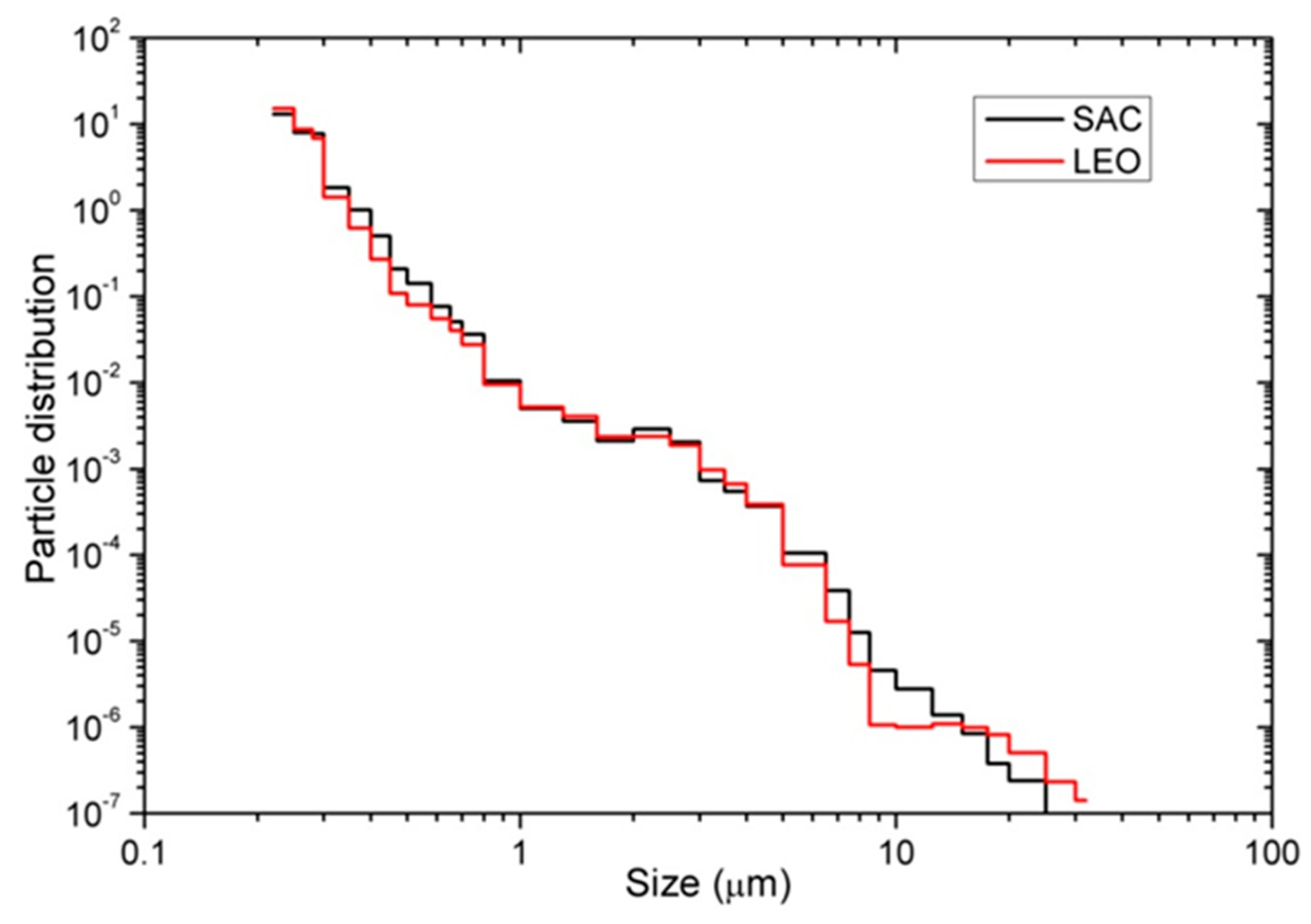
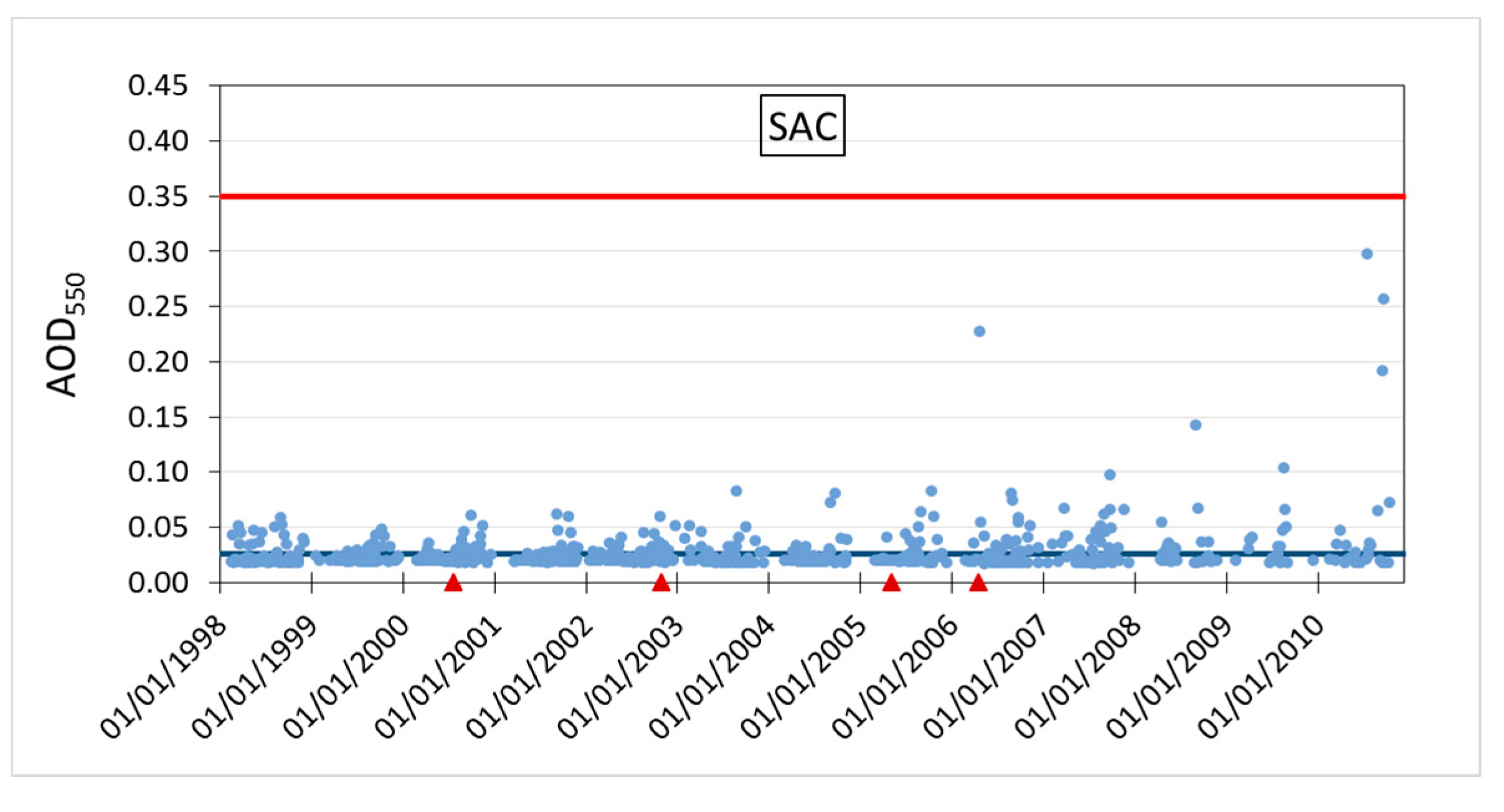
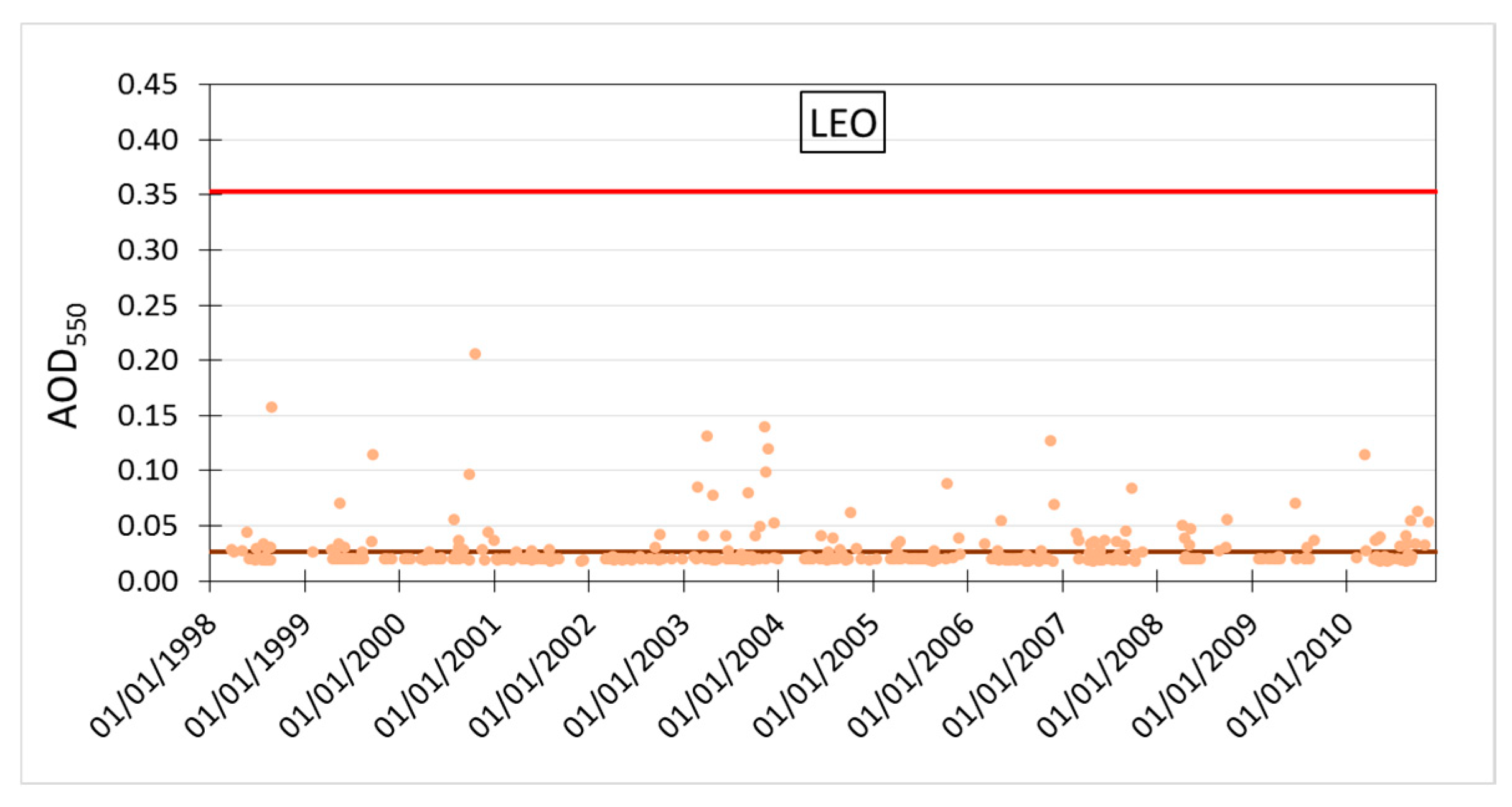
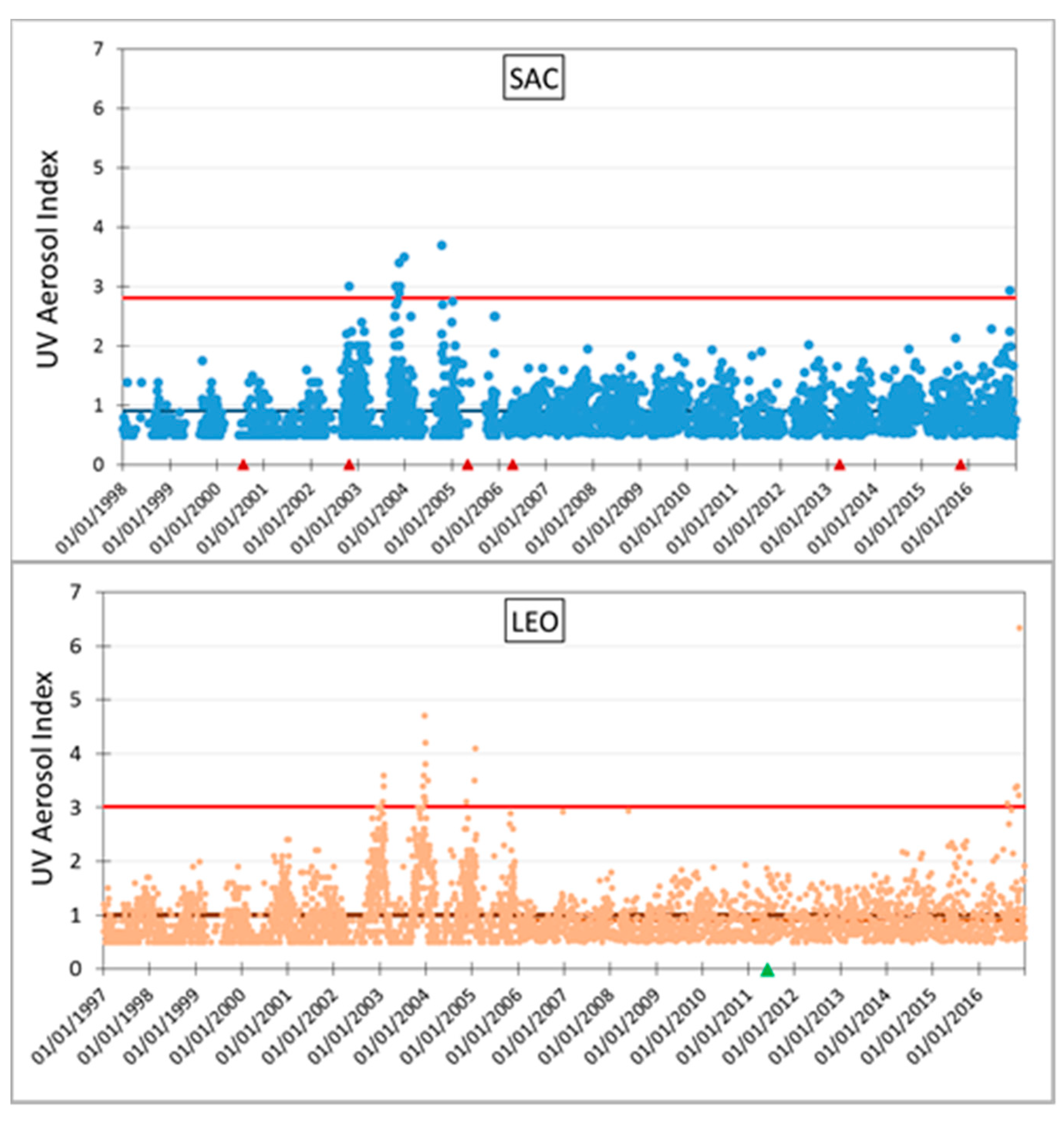
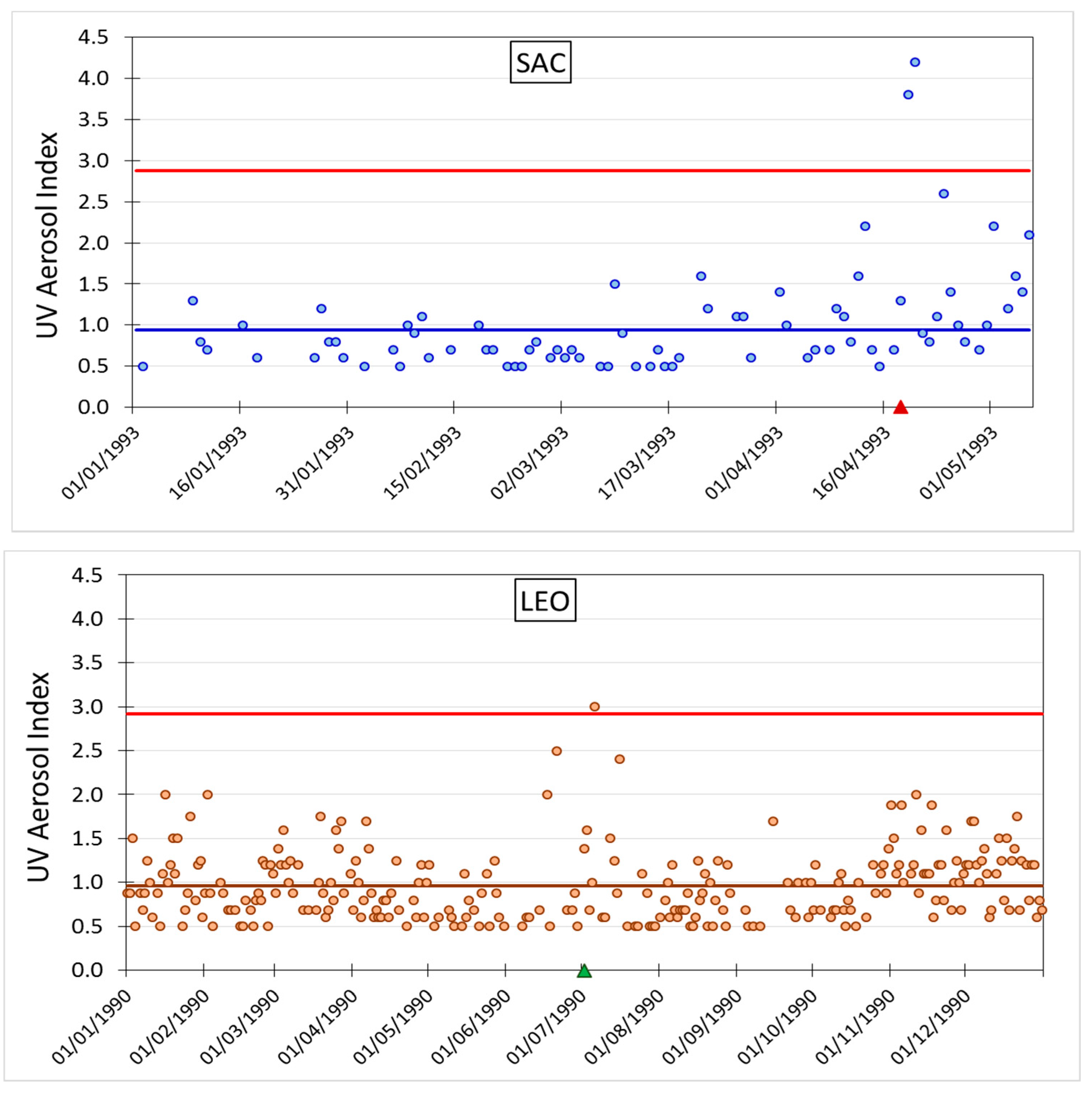
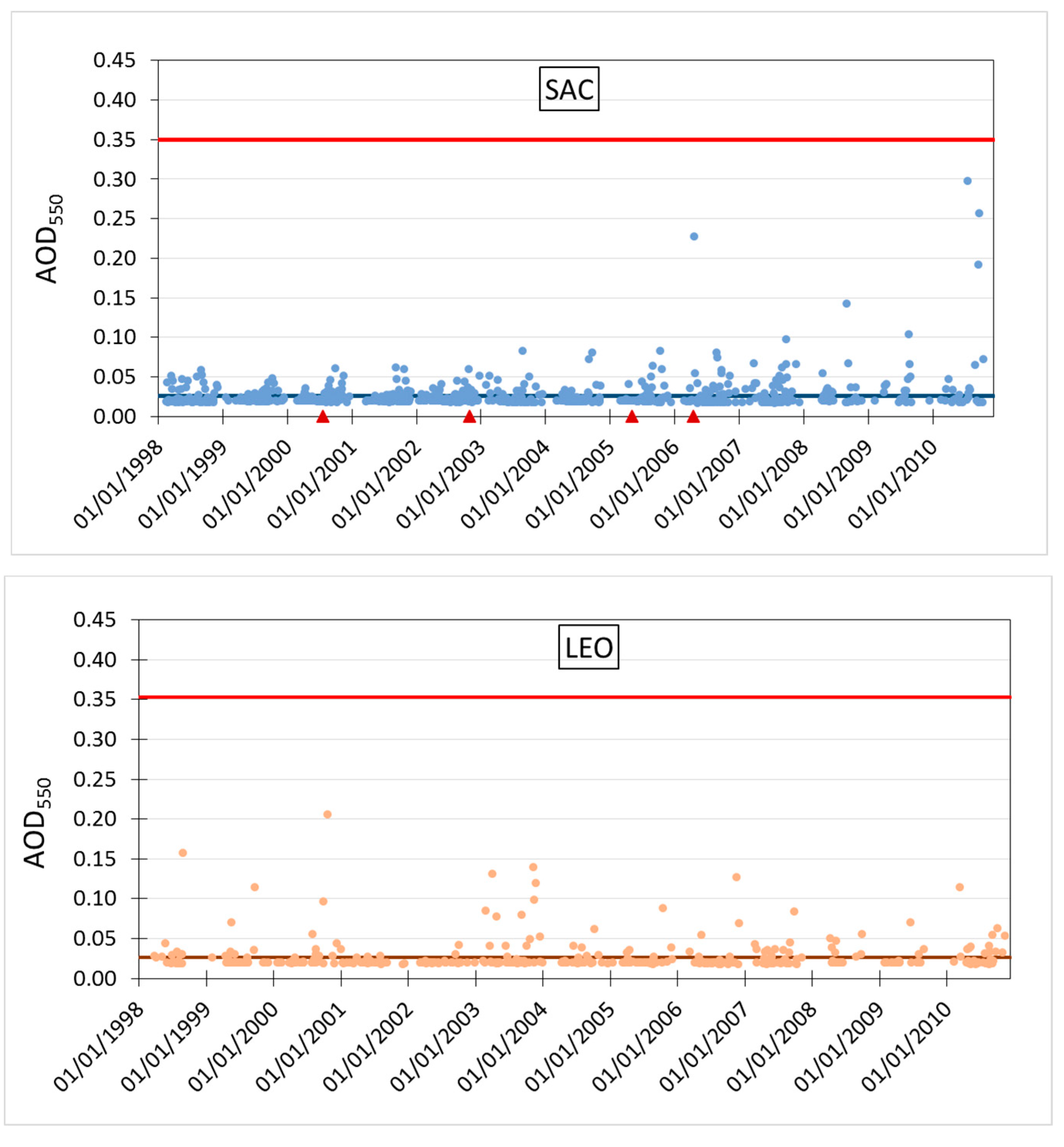

| LEO | SAC | |
|---|---|---|
| PM2.5 | 18.70 | 22.04 |
| PM2.5-10 | 45.39 | 55.08 |
| PM10 | 64.09 | 77.12 |
| PM > 10 | 35.91 | 22.88 |
| LEO | SAC | |
|---|---|---|
| PM2.5 | 99.7700 | 99.7737 |
| PM2.5-10 | 0.2286 | 0.2248 |
| PM10 | 99.9986 | 99.9985 |
| PM > 10 | 0.0014 | 0.0015 |
Publisher’s Note: MDPI stays neutral with regard to jurisdictional claims in published maps and institutional affiliations. |
© 2017 by the authors. Licensee MDPI, Basel, Switzerland. This article is an open access article distributed under the terms and conditions of the Creative Commons Attribution (CC BY) license (https://creativecommons.org/licenses/by/4.0/).
Share and Cite
Della Ceca, L.S.; Micheletti, M.I.; Freire, M.M.; García, B.; Piacentini, R.D. SO2 and Aerosol Evolution over the Very Clear Atmosphere at the Argentina Andes Range Sites of San Antonio de Los Cobres and El Leoncito. Proceedings 2017, 1, 197. https://doi.org/10.3390/ecas2017-04153
Della Ceca LS, Micheletti MI, Freire MM, García B, Piacentini RD. SO2 and Aerosol Evolution over the Very Clear Atmosphere at the Argentina Andes Range Sites of San Antonio de Los Cobres and El Leoncito. Proceedings. 2017; 1(5):197. https://doi.org/10.3390/ecas2017-04153
Chicago/Turabian StyleDella Ceca, Lara S., María I. Micheletti, Martín M. Freire, Beatriz García, and Rubén D. Piacentini. 2017. "SO2 and Aerosol Evolution over the Very Clear Atmosphere at the Argentina Andes Range Sites of San Antonio de Los Cobres and El Leoncito" Proceedings 1, no. 5: 197. https://doi.org/10.3390/ecas2017-04153




